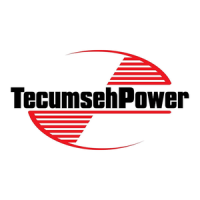
Do you have a question about the Tecumseh OVXL120 and is the answer not in the manual?
| Lubrication System | Splash |
|---|---|
| Ignition System | Solid State |
| Spark Plug | Champion RJ19LM or Equivalent |
| Fuel Type | Unleaded Gasoline |
| Governor Type | Mechanical |
| Oil Capacity | 20 oz (0.6 L) |
| Carburetor | Float Type |
| Starting System | Recoil |
| Rotation | Counterclockwise (from PTO side) |
| PTO Shaft | 3/4 in diameter, various lengths |
| Engine Type | 4-Cycle, Overhead Valve, Single Cylinder, Air Cooled |
Identifies engine model, specification, and serial numbers.
Recommendations for using clean, unleaded gasoline and fuel types.
Requirements for clean, high-quality detergent oil for four-cycle engines.
Table listing oil capacities for various engine models.
Explains the function of the air cleaner in removing dust and dirt.
Identifies air filter issues causing poor engine performance.
Service instructions for cleaning and oiling polyurethane air filters.
Instructions for replacing paper air filter elements.
Method for cleaning or replacing a flocked screen filter.
Overview of float-type and Walbro carburetors used in Tecumseh engines.
Explains fuel-air mixture delivery during choke, idle, and high-speed operation.
Guides for visually identifying different carburetor series based on features.
Procedures for checking for spark, fuel flow, and engine compression.
Steps for setting and adjusting carburetor mixture screws and idle speed.
Procedures for fine-tuning main and idle mixture screws for optimal performance.
Explains the governor's role in maintaining engine RPM under varying loads.
Diagnoses engine problems related to overspeeding and surging caused by governor issues.
Procedures for governor adjustment and service of governor gear and shaft.
Covers adjustments for remote and governed idle speed controls.
Describes how recoil starters engage the engine flywheel for starting.
Procedures for rope service, retainer replacement, and starter disassembly.
Disassembly and assembly procedures for common rewind starter types.
Specific disassembly and assembly steps for this starter type.
Disassembly procedure for keeper spring style recoil starters.
Overview of battery, starting, and charging circuits in Tecumseh engines.
Details how diodes and rectifiers convert AC to DC for battery charging.
Guidelines for checking wiring insulation, connections, and condition.
Steps to test the engine's starting circuit for voltage and continuity.
Procedures for testing the engine's charging system output at various RPMs.
Specific test procedure for the 350 milliamp charging system.
Testing the 2.5 Amp DC / 35 Watt AC lighting alternator system.
Checking the 5 Amp DC alternator system with an under-blower housing regulator.
Testing the combined 3 Amp DC and 5 Amp AC alternator system.
DC voltage checks for OVM/OVXL/OHV12.5 models.
AC voltage checks for OVM/OVXL/OHV12.5 lighting circuits.
Testing DC and AC output for OHV 13.5-17 engines.
Checking AC output from the 10 Amp AC alternator system.
Testing the 16 Amp alternator system with an external regulator.
Procedure for checking voltage regulator function by monitoring battery voltage.
Service procedures for 12 and 120 volt electric starters.
Disassembly and assembly steps for electric starters.
Step-by-step guide for replacing starter motor brush cards.
Explains the function and compliance standards of flywheel brake systems.
Describes how the brake system stops the flywheel and grounds ignition.
Lists parts of the brake bracket assembly, kill switch, and interlock switch.
Testing and replacing the starter interlock switch for safety.
Checks for proper control cable adjustment for brake engagement.
Proper alignment procedures when installing a brake bracket assembly.
Overview of solid state capacitor discharge ignition systems.
Explains how flywheel magnets, coils, and SCR generate spark.
Proper methods for cleaning, adjusting, and replacing spark plugs.
Checking ignition module air gap and flywheel magnet strength.
Covers engine components like cylinder, crankshaft, valves, and governors.
Explains the four-stroke engine cycle: intake, compression, power, and exhaust.
Troubleshooting guides for common engine issues like knocks, overheating, and surging.
Troubleshooting steps for diagnosing and resolving engine power loss issues.
Step-by-step guide for disassembling the engine.
Inspection, measurement, and reconditioning procedures for cylinder bores.
Procedures for checking cylinder head warpage and servicing valves.
Inspection and replacement of pistons, rings, and connecting rods.
Inspection and timing procedures for crankshafts and camshafts.
Procedures for reaming and installing valve guides.
Procedures for removing and installing oil seals using special tools.
Procedures for servicing crankshaft ball bearings.
General procedures for assembling engine components with new gaskets and seals.
Cross-reference chart for Tecumseh engine models and Sears Craftsman part numbers.
Lists engine specifications and tolerances for various models.
Torque values for cylinder head bolts across different engine models.
Torque specifications for connecting rod bolts.
Torque values for cylinder cover and flange screws.
Torque specifications for flywheel nuts.
List of available technical handbooks for engine and power train repair.
Catalog of VHS video programs covering carburetor and ignition system repair.
List of specialized booklets on failure analysis, carburetors, and ignition.
Manuals detailing test procedures for electrical components using specific testers.
Contents of the tool kit for servicing 2 and 4-cycle engines.
